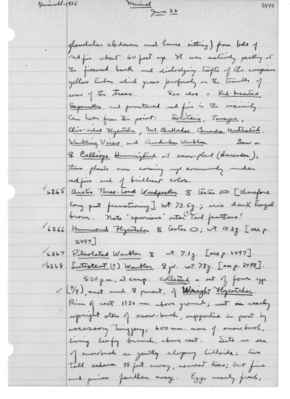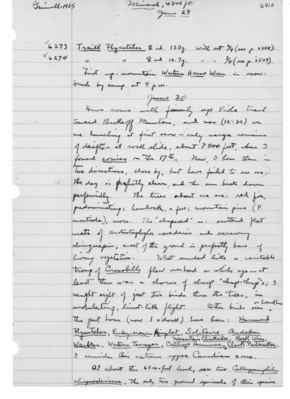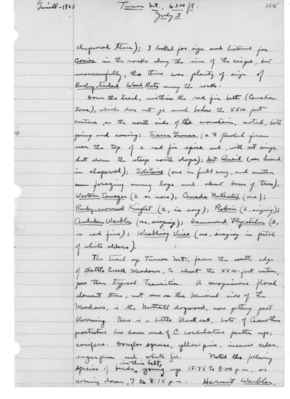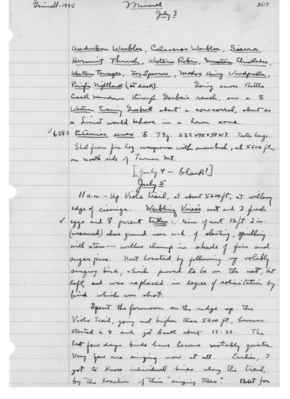Pages That Mention Audubon's Yellow-rumped Warbler
1925: Joseph Grinnell's field notes
S2 Page 45
Collector: Grinnell - 1925 Location: Mineral Date: June 26 Page Number: 2499
glandular abdomen and hence sitting) from bole of red fir about 60 feet up. It was actively pecking at the fissured bark and dislodging tufts of the conspicuous yellow lichen which grows profusely on the trunks of some of the trees. Saw also a Red-breasted Sapsucker, and punctured red fir in the vicinity. Can hear from this point: Solitaire, Tanager, Olive-sided Flycatcher, Mt. Chickadee, Canada Nuthatch, Warbling Vireo, and Audubon Warbler. Saw a [female symbol] Calliope Hummingbird at snow-plant (Sarcodes); these plants now coming up commonly under red firs and of brilliant colors.
6265 Arctic Three-toed Woodpecker [male symbol] testes [illustration] [therefore long past functioning] wt. 73.5g.; iris dark hazel brown. Note "spurious" outer ^(?) tail feathers!
6266 Hammond Flycatcher [male symbol] testes [illustration]; wt. 10.2g. [see p. 2497].
6267 Pileolated Warbler [male symbol] wt. 7.1g. [see p. 2497].
6268 Lutescent (?) Warbler [female symbol] jv. wt. 7.8g. [see p. 2498].
5:00p.m., at camp: collected a set of four eggs 4/4, nest and female parent, of Wright Flycatcher. Rim of nest 1130mm above ground; nest on nearly upright stem of snow-bush, supported in part by accessory twiggery; 600 mm. more of snow bush, living leafy branch, above nest. Site in sea of snowbush on gently sloping hillside; two tall cedars 75 feet away, nearest trees; but firs and pines farther away. Eggs nearly fresh;
S2 Page 57
Collector: Grinnell - 1925 Location: Mineral, 4800 ft. Date: June 29 Page Number: 2510
6273 Traill Flycatcher [female symbol] ad. 13.0 g. with set 3/4 (see p. 2508). 6274 Traill] [Flycatcher] [female symbol] ad. 12.7 g. [with] [set] 3/4 (see p. 2509).
First up - mountain Western House Wren in snow brush by camp at 4 p.m.
June 30 Have come with family up Viola trail towards Brokeoff Mountain, and now (12:30) we are lunching at first snow - only meagre remains of drifts - at rock slide, about 7500 feet, where I found conies on the 17th. Now, I hear them in two directions, close by, but have failed to see one. The day is perfectly clear, and the sun beats down perfervidly. The trees about me are: red fir, predominating; hemlock, a few; mountain pine (P. monticola), more. The "chaparral" is: scattered flat mats of arctostaphylos nevadensis and scrawny chinquapin; most of the ground is perfectly bare of living vegetation. What sounded like a veritable troup of Crossbills flew overhead a while ago - at least there was a chorus of sharp "chup-chup's"; I caught sight of just two birds thru the trees, in undulating, linnet-like flight. Other birds seen ^or heard here the past hour (now 1 o'clock) have been: Hammond Flycatcher, Ruby-crown Kinglet, Solitaire, Audubon Warbler, Western Tanager, Calliope Hummer,^ Mountain Chickadee, Rock Wren, Clark Nutcracker. I consider this extreme upper Canadian zone.
At about 6500-foot level, saw two Callospermophilus chrysodeirus, the only two ground squirrels of this species
S2 Page 65
Collector: Grinnell - 1925 Location: Turner Mt., 6300 ft. Date: July 3 Page Number: 2518
chaparral there); I looked for sign and listened for Conies in the rocks along the rim of the cirque, but unsuccessfully, tho there was plenty of sign of Bushy-Tailed Wood Rats among the rocks.
Down the trail, within the red fir belt (Canadian Zone), which does not go much below the 5500 foot contour, on the north side of the mountain, noted, both going and coming: Sierra Grouse (a [male symbol] flushed from near the top of a red fir spire and, with set wings, shot down the steep north slope); Mt. Quail (one heard in chaparral); Solitaire (one in full song, and another seen foraging among logs and about bases of trees); Western Tanager (2 or more); Canada Nuthatch (one); Ruby-crowned Kinglet (2, in song); Robin (2, singing); Audubon Warbler (one, singing); Hammond Flycatcher (2, in red firs); Warbling Vireo (one, singing in patch of white alders).
The trail up Turner Mt. from the south edge of Battle Creek Meadows, to about the 5500-foot contour, goes thru [sic] typical transition. A conspicuous floral element there, not seen on the Mineral side of the Meadows, is the Nuttall dogwood, now getting past blooming. There is a little black oak, lots of Ceanothus prostratus low down and of C. cordulatus farther up; conifers: Douglas spruce, yellow pine, incense cedar, sugar pine, and white fir. Noted the following species of birds ^in this belt, going up 12:45 to 3:00 p.m., or coming down, 7 to 8:15 p.m.: Hermit Warbler,
S2 Page 66
Collector: Grinnell - 1925 Location: Mineral Date: July 3 Page Number: 2519
Audubon Warbler, Calaveras Warbler, Sierra Hermit Thrush, Western Robin, Mountain Chickadee, Western Tanager, Fox Sparrow, Modoc Hairy Woodpecker, Pacific Nighthawk (at dusk). Going across Battle Creek Meadows through Gerber's (?) ranch, saw a [male symbol] Western Evening Grosbeak about a cow-corral, about as a Linnet would behave in a lower zone.
6283 Eutamias senex [male symbol] 79g. 232x98x34x17. Testes large. Shot from fir log overgrown with snowbush, at 5500 ft., on north side of Turner Mt.
July 4 - blank!]
July 5 11 a.m. - Up Viola trail, at about 5600 ft., at willowy edge of cienaga. Warbling Vireo's nest and 3 fresh eggs and female parent taken: rim of nest 12 ft. 2 in. (measured) above ground near end of slanting, spindling will [sic] stem - willow clump in shade of firs and sugar pine. Nest located by following up volubly singing bird, which proved to be on the nest, but left, and was replaced in degree of solicitation by bird which was shot.
Spent the forenoon on the ridge up the Viola Trail, going not higher than 5600 ft., however. Started a [sic] 8 and got back about 12:30. The last few days birds have become notably quieter. Very few are singing now at all. Earlier, I got to know individual birds along the trail, by the location of their "singing trees." But for
S2 Page 67
Collector: Grinnell - 1925 Location: Mineral Date: July 5 Page Number: 2520
the most part, there [sic] are silent now. Tanagers, Hermit Thrushes and Warbling Vireos are still in song; but nearly all warblers, flycatchers and finches are quiet. Indeed, I heard the song of but one Hermit Warbler, where I heard dozens on June 22. Heard but 2 or 3 Audubon Warblers this morning. Heard a Grouse "boonting" in a big fir, so persistently that I circled the tree without disturbing him. I couldn't see him. Flushed a hen from the dusty trail, but failed to find any young.
6284 Hammond Flycatcher [female symbol] ad. 9.7g. Shot from fir twig about 30 ft. from ground in woods on ridge at 5500 ft. Note that molt has begun in innermost primaries, and that lower mandible is not especially dusky; indeed, it is quite pale flesh-color.
6285 Warbling Vireo [female symbol] 13.7 g. Contained fully formed yolk, a little "white" but not shell: would have laid 4th egg tomorrow. With nest and set 1/3 (incomplete, as above. ^Shot in willow. See p. 2519.
6286 Western Tanager [male symbol] ad. testes [testes illustration]. 28.6 g. Shot on ground beneath young firs, whither it had just; 5000 ft.
6287 Mariposa Fox Sparrow [female symbol] ad. 30.7g. Shot in thicket of arctostaphylos patula, in large tract of chaparral at about 5600 ft.
The young in the Wright Flycatcher's nest at camp, which hatched on June 17 (see p. 2491), left the nest voluntarily this forenoon sometime. Time in nest, 18 days ±.
6288 Bufo boreas found under board in our tent.




